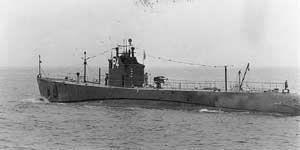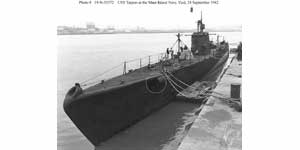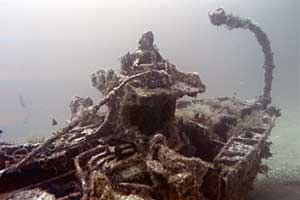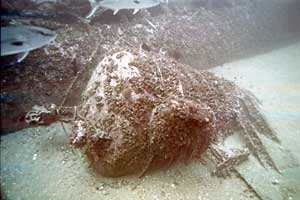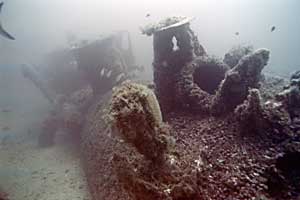
TARPON operated out of San Diego and Pearl Harbor with Submarine Division (SubDiv) 13 for several years and was then assigned to SubDiv 14. In October 1939, SubDiv 14 was transferred to the Philippines, augmenting the six old S-boats at Manila. All submarines there were then reorganized into Submarine Squadron 5. In October 1941, SubDivs 15 and 16 were transferred from Pearl Harbor to Manila, increasing the Asiatic force to 29 submarines. They were divided into five divisions, and TARPON was assigned to SubDiv 203.
Two days after the Japanese attacked Pearl Harbor, 18 submarines departed the Philippines to begin their first war patrol. TARPON was assigned an area off southeastern Luzon. Since all the ships that she definitely identified as Japanese presented unfavorable firing angles, the submarine ended her patrol on 11 January 1942 at Darwin, Australia, without having fired a torpedo.

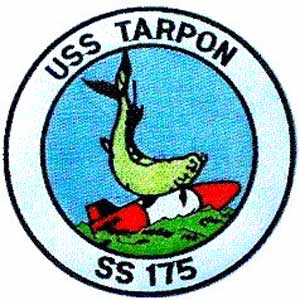
TARPON's third patrol began on 28 March and ended at Pearl Harbor on 17 May with no contacts except a hospital ship. Her next mission, which took her north of Oahu, lasted only 10 days, from 30 May to 9 June; but the submarine contacted no enemy shipping. She was then routed back to San Francisco for an overhaul which was completed on 30 September.
On 22 October, TARPON stood out of Pearl Harbor to begin her fifth war patrol which took her to waters north of Bougainville. She sighted many fishing boats which were not worthy of a torpedo and terminated the patrol at Midway on 10 December 1942.

TARPON's seventh patrol, conducted from 29 March to 15 May, produced no ship contacts; but the submarine did bombard the radio station at Taroa with her deck gun until shelling from Japanese batteries ashore prompted her to withdraw from the area.
On 30 July, TARPON again headed for Japanese home waters. On 16 August, she sighted a Japanese task force which included an escort aircraft carrier of the OTAKA (TAIYO) class, but its high speed prohibited an attack. On the 21st, the submarine contacted two large, escorted, cargo ships. She fired a spread of three torpedoes at each and damaged both targets. Seven days later, TARPON damaged another freighter as it was leaving Mikura Shima. On 4 September, she sank a patrol ship with all hands and then returned to Midway on 8 September.
TARPON conducted her ninth war patrol off the coast of Honshu from 1 October to 3 November. On the night of 16 October, she was patrolling the approaches to Yokohama when she sighted a ship which she tentatively identified as a large auxiliary. The submarine tracked the target until 0156 the next morning when she attacked it with four torpedoes which stopped it dead in the water. However, it soon got underway again and headed straight for TARPON. The submarine submerged, went under the ship, and attacked the target from the other side with three more torpedoes which produced one hit in the stern. The enemy still did not sink, so TARPON fired again with a torpedo which struck the target in the same place as the first. The vessel exploded and disappeared. Postwar examination of enemy records revealed that the victim was the German commerce raider MICHEL (Shiff-28) which had been preying on Allied shipping in both the Atlantic and the Pacific. MICHEL was the first German raider sunk by a United States submarine in the Pacific.

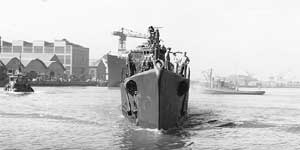
Mare Island Naval Yard, California (6)
Mare Island Naval Yard, California (6)
Four days later, TARPON contacted an aircraft carrier and a destroyer. She made a submerged approach and fired four torpedoes at the carrier. However, both ships speeded up and eluded the deadly missiles. On the morning of 23 October, the submarine made radar contact on two ships and fired five torpedoes at the larger target. All apparently passed under the freighter. The submarine returned to Pearl Harbor on 3 November.
TARPON's next war patrol, which lasted from 4 December 1943 to 12 January 1944, took her to the Marshall Islands. Besides photographing the various atolls--her primary mission--she fired two torpedoes at an inter-island tanker, but both missed. From 19 June to 8 August, TARPON performed lifeguard duty in the Truk area, but made no rescues. On 14 July, she fired three torpedoes at what was thought to be an inter-island freighter. All missed, and the ship turned out to be a disguised antisubmarine ship. TARPON went deep to evade the depth charges and cleared the area. On the 25th, she made radar contact on a small convoy and fired three torpedoes at the largest ship. All missed, and the submarine closed to engage with her deck guns. After the second shot, the gun jammed, and only the machine guns continued firing. TARPON withdrew to clear the gun and then returned to the attack. She inflicted considerable damage on the enemy ship before she was outgunned and forced to break off the engagement. TARPON's final war patrol, from 31 August to 14 October, consisted of lifeguard duty in the Truk area. When she returned to Pearl Harbor, she was ordered to the east coast of the United States. The submarine departed Pearl Harbor on Christmas Eve, 1944, and arrived at New London, Conn., on 17 January 1945. After operations on the east coast, TARPON was decommissioned at Boston on 15 November 1945. Early in 1947, the submarine was scheduled for duty as a Naval Reserve training ship. TARPON left Boston under tow on 28 March and arrived at New Orleans on 9 April and was placed in service there on the 17th. She served as a training submarine in the 8th Naval District until placed out of service and struck from the Navy list on 5 September 1956. She was later sunk in deep water, probably as a target, southeast of Cape Hatteras, N.C., on 26 August 1957. TARPON received seven battle stars for World War II service. [TARPON foundered while under tow to the scrap yard.
